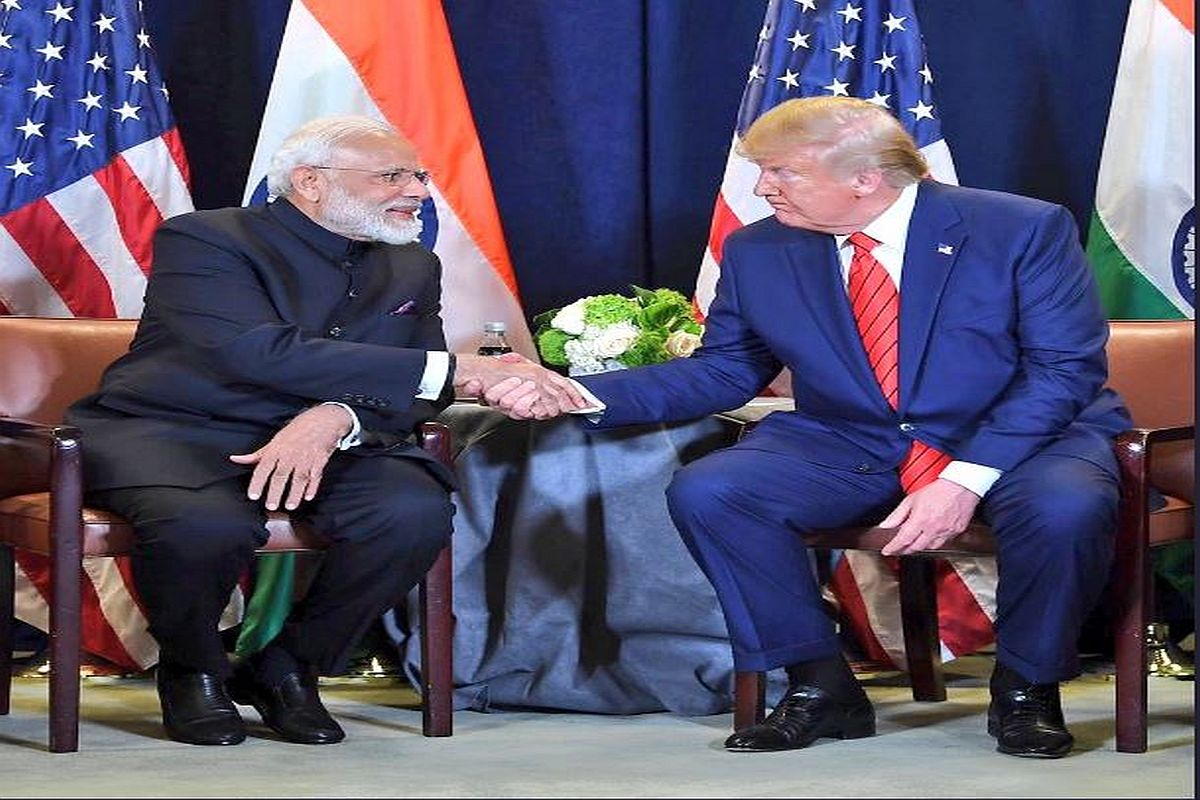A vote for BJP will ensure Tripura’s prosperity: PM to Agartala electorate
Modi claimed that the North East policy of the Congress and the Communists was a Loot East policy, which the BJP buried 10 years back and initiated an Act East Policy.
However, the American president did not side with either country and has ultimately said diplomatically, “Fellas, Work it out (Kashmir)” to both Khan and Modi after his meetings with them.

Trump even called Modi “an American version of Elvis”, referring to the 'Howdy, Modi' event. (Photo: Twitter/@MEAIndia)
Prime Minister Narendra Modi is back after a week-long visit to the United States. It is being touted as one of his most successful visits. Modi had gone to New York and Houston as a much stronger leader after his impressive win four months ago. What are the takeaways of this high-profile visit? The biggest is that Modi has risen in the eyes of not only the Indian Diaspora but also the US. He has consolidated his rock star image when President Trump compared him with Elvis Presley.
Modi wanted to impress upon the world that he is a decisive and aggressive politician and he has by and large succeeded in this. Before leaving for New York, the Prime Minister said, “Through my participation in UN events, I will showcase our success in realising the Sustainable Development Goals. At the Climate Action Summit on September 23, I will highlight India’s robust action to address climate change in line with global goals and our international commitments. I am confident that my visit would present India as a vibrant land of opportunities, a reliable partner and a global leader, and will also help impart new energy to our relations with the US.”
He succeeded mostly in this regard. Indeed the visit was dominated by the mega “Howdy Modi” event organized by the Indian Diaspora in Houston on September 22. It was not only the 50,000 strong crowd which lustily cheered the visiting Prime Minister but also the fact that President Trump shared the dais. It was a winwin situation for both leaders. The Washington Post noted, “For Trump, the rally provides access to a pool of voters – Indian Americans – that he hopes to court in next year’s presidential elections, even if the community tends to lean heavily Democratic.” The mega event also raised the profile of Indian Americans in the US where their clout is already on the increase. Modi has certainly wowed the Americans with his rock star image.
Advertisement
He has exhibited to the American establishment his comfortable personal equation with Trump. The presence of about 40 US lawmakers at the event revealed the bipartisan support for India. Modi has certainly raised the level of India by engaging with a number of global leaders – small and big. He had the objective of a larger outreach this time. For the first time, he held leadership-level interactions with the leaders of the Pacific Island States and leaders of the CARICOM group on the margins of UNGA. As for investment, Modi made a huge pitch with the business community by interacting with them – both in Houston and in New York. The round table in Texas with top executives of 16 oil and gas companies was indeed impressive.
The LNG deal in Houston was a big push. The Prime Minister has successfully projected India as an investor, provider of jobs to Americans and destination for future Indo-US projects. However, in the bilateral meeting, though Trump and Modi reviewed the ongoing trade negotiations, an agreement remained elusive. The US is India’s largest trade partner and exports from India to the US in 2018- 19 were estimated at $52.42 billion. Trump was upset about the huge trade deficit and wanted New Delhi to eliminate tariffs (20 per cent) on information and communication technology products, and remove price caps on medical devices like stents.
India, on the other hand, wanted the US to reinstate the Generalized System of Preferences (GSP) program revoked in June and greater market access in certain categories of agricultural products, as also better facilitation processes. The negotiations were inconclusive though a deal had been expected in New York. At the UN climate change summit, the paradigm shift was that India was willing to do whatever it could instead of the earlier stand that other countries, which are more responsible for the situation, should do so first. At the UNGA, Modi made a statesman-like speech while Imran Khan predictably internationalised the Kashmir issue. Modi focused on India’s role in development, peace and security, with no mention of Article 370, which is considered an “internal issue.”
However, the American president did not side with either country and has ultimately said diplomatically, “Fellas, Work it out (Kashmir)” to both Khan and Modi after his meetings with them. For New Delhi, this was a gain after his earlier offer of mediation. On the whole, the visit had impressive optics. New Delhi and Washington feel ties have deepened and strengthened. The impact of the visit will be known in the coming months. However, there are two things – the economy and normalisation of the situation in Kashmir – which will decide how the international community looks at India and whether human rights groups will become active if normalisation is delayed further and political leaders are not released.
Advertisement